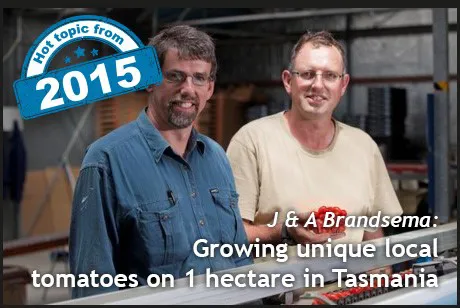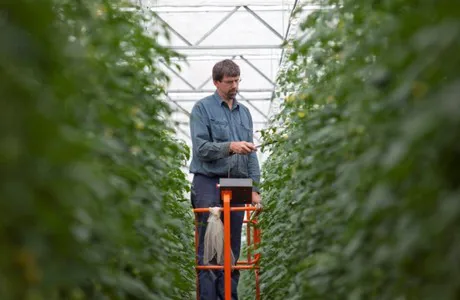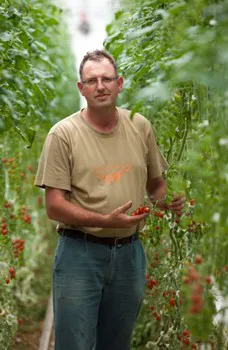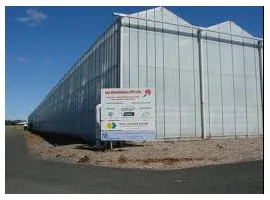
Anthony and Marcus Brandsema
The greenhouse acreage of the Brandsema's does not have the average size of an Australian greenhouse company. But that doesn't mean it is less efficient. The current hectare that they have can create more than enough work for 12 full time employees and a total of 32 seasonal workers in the picking season.
Cheramy RZ
"So far it has been a pretty good season, we are picking ahead of budget, which is good. It looks like we will have a good year", Anthony said. The cropping season at Brandsema in Tasmania usually starts in July. "First planting in the glasshouse is early, usually 21st of June 2014, the shortest day. This crop continues till the first week of June 2015. The plastic house is planted later, mid July", Anthony said. "We are growing Rijk Zwaan's Cheramy for the fifth consecutive year. We are very happy with the variety, it might not provide the highest yields, but it tastes very good."
Marcus Brandsema pollinating the crops
All of the tomatoes at Brandsema are picked loose and packed in to 250 gram clamshells. The grower focusses on the local market: everything is sold straight to supermarket chains and independent retailers in Tasmania. Also corner-shops, veggie sheds or other businesses that want tomatoes come to them direct. "If customers appreciate locally grown produce, they are willing to pay a bit more for this."

Anthony Brandsema in the glasshouse
Unique selling point
Brandsema's tomatoes have a unique selling point on the Tasmanian market: they are grown locally. And he is one of only two greenhouse tomato growers on the island. "There is not that much competition. The other tomato suppliers to Tasmania are larger growers from Victoria and NSW. But they only ship TOV's to Tasmania. We can't compete with them in terms of price, so it makes no sense to try to. That is why we grow other varieties that are hard to import. Besides this, all of the import needs to be fumigated, a time consuming process that is not contributing to the quality." Besides the Cheramy crop they also grow Syngenta's Angelle on contract for Tomato Exchange in NSW. Some of these tomatoes are shipped back to Melbourne. On a daily basis this is about 10-15 half pallets a week.
Besides the Cheramy crop they also grow Syngenta's Angelle on contract for Tomato Exchange in NSW. Some of these tomatoes are shipped back to Melbourne. On a daily basis this is about 10-15 half pallets a week. Innovation
Growing on just one hectare is not always that efficient said Anthony. He admits that they needed to be very innovative to increase the efficiency of the business. "In 2006, I won the Nuffield Scholarship which made me capable of travelling a lot in order to gather inspiring ideas. I went to Canada and learned how growers increased their energy efficiency with Biomass boilers. In 2007, we installed a biomass boiler ourselves in that burns woodwaste, woodchips and forest waste. Next to this we have LPG on site and we run a buffer tank. We use the LPG on nice and bright conditions for the CO2. And in the winter we also have the biomass boiler for supplementary heating. The gas prices are really high, it is too expensive, so we need to have innovative alternatives available for this." The original plastic house, a Richel structure, was built by the Brandsema's themselves. The glasshouse was built by Faber Greenhouses from New Zealand.
The original plastic house, a Richel structure, was built by the Brandsema's themselves. The glasshouse was built by Faber Greenhouses from New Zealand. Expansion
In order to increase the efficiency of their businesses, many greenhouse growers feel the urge to expand their acreage. But this is not the case at Brandsema. "We have run out of land where we are at the moment", he laughs. "We have a very small block and we are in the middle of town. What we want to do is make sure that we get the best return from our operation as it stands now. This can be achieved by selling more produce directly to customers rather than to supermarkets. We need to get better value for the product first. Once we have explored these possibilities, we can then determine if the market is good and valuable enough for us to expand. We are not quite there yet."[email protected]
